- Home
- Colleen McCullough
On, Off Page 2
On, Off Read online
Page 2
“Where’s Otis now?” Carmine asked.
“Knowing Otis, he run home to Celeste. She his mama as well as his wife.”
They were gloved now; Abe wheeled the bin away from the door and Carmine opened it as Cecil, already crooning and clucking, went into the monkey room.
Of the two big bags, one still lay at the back of the chamber. The other, rent from where the top folded over clear to the bottom, had exposed the lower half of a female torso. When Carmine noted its size and its lack of pubic hair his heart sank — a prepubescent child? Oh, please, not that! He made no movement to touch a thing, just leaned his shoulders against the wall.
“We wait for Patrick,” he said.
“I never smelled a smell like it — dead, but not decomposing,” said Abe, dying for a cigarette.
“Abe, go find Mrs. Dupre and tell her she can go upstairs as soon as the uniforms arrive,” Carmine said, knowing that expression well. “Post them on all the entrances and emergency exits.” Then, alone with Corey, he rolled his eyes. “Why in there?” he asked.
Patrick O’Donnell enlightened him.
Sporting the very modern title of Medical Examiner in a city that had always had a coroner without forensic skills in earlier days, Patrick had espoused pathology because he didn’t like patients who talked back, and the life of a public pathologist because it meant plenty of criminal cases as well as all the other kinds of sudden or mysterious death. Thanks to Patrick’s ruthless campaign to bring Holloman into the latter half of the twentieth century, he had managed to shed most of a coroner’s court duties on to a deputy coroner and build a little empire that encompassed far more than mere autopsies. He believed in the new science of forensics, and played an active part in any case that interested him, even if no body was involved.
He looked as Irish as his name from the reddish hair to the bright blue eyes, but in actual fact he and Carmine were first cousins, the sons of two sisters of Italian extraction. One married a Delmonico, the other an O’Donnell. Ten years older than Carmine and a happily married man with six children, Patrick let neither of these impediments spoil their deep friendship.
“I don’t know much, but here’s what I do know,” said Carmine, and filled him in. “Why in there?” he repeated at the end of it.
“Because if Jimmy the monkey hadn’t woken up undead and flown into a panic, these two brown bags, unmarked and intact, would have been dumped into some kind of receptacle and taken to the animal care incinerator,” Patrick said, grimacing. “This is the perfect way to get rid of human remains. Poof! Up in smoke.”
Abe came back in time to hear this, and went pale. “Jeez!” he breathed, horrified.
Photographs taken, Patrick lifted the first bag onto a gurney and tucked it inside an open body bag. Then he examined what he could see without disturbing the torn brown paper.
“No pubic hair,” said Carmine. “Patsy, if you love me, tell me this isn’t a child.”
“The hair’s been — not shaved — no, plucked — so she’s postpubescent. Small girl, though. As if what our killer really yearned for was a child, but wasn’t game to follow through on all his disgusting desires.” He lifted out the second bag, not as mangled, and placed it beside the first. “I’ll get back to the morgue — you’ll want my report a.s.a.p.” His chief technician, Paul, was already preparing to vacuum the chamber’s interior; after that he would dust for fingerprints. “Lend me Abe and Corey as well, Carmine, and we can let Cecil get on with his work. Except for the monkeys, they must keep their experimental animals elsewhere — these are the day’s clean cages ready to go.”
“Leave no stone unturned, guys,” said Carmine, following his cousin and the gurney’s grisly contents out.
Desdemona Dupre — what a strange name! — was in the foyer waiting, flicking through the contents of a thick sheaf of papers on her clipboard.
“Mrs. Dupre, this is Dr. Patrick O’Donnell,” said Carmine.
Whereupon the woman bristled! “I am not a missus, I am a miss!” she said with a snap, that odd accent pronounced. “Are you coming upstairs with me, Lieutenant, or may I go? I have work to do.”
“Catch you later, Patsy,” said Carmine, following Miss Dupre into an elevator.
“You’re from, uh, England?” he asked as they ascended.
“Correct.”
“How long have you been at the Hug?”
“Five years.”
They left the elevator on the fourth floor, which was the top floor, though the last button said ROOF. Here the Hug’s interior decor was better displayed. It was little different from the first floor: walls painted institution cream, dark oak woodwork, banks of fluorescent ceiling lights under plastic diffusers. Back down a twin of that first-floor corridor to a door opposite its far end, where it met another hall at right angles.
Miss Dupre knocked, was bidden enter, and pushed Carmine into Professor Smith’s private domain without entering herself.
He found himself staring at one of the most strikingly handsome men he had ever seen. Robert Mordent Smith, William Parson Chair Professor at the Hughlings Jackson Center for Neurological Research, was over six feet tall, on the thin side, and possessed an unforgettable face: wonderful bone structure, black brows and lashes, vivid blue eyes, and a mop of wavy, streaky white hair. On someone still young enough not to have lines or wrinkles, the hair set him off to perfection. His smile revealed even white teeth, though the smile wasn’t reaching those marvelous eyes this morning. No surprise.
“Coffee?” he asked, gesturing Carmine to the big, costly chair on the opposite side of his big, costly desk.
“Thanks, yes. No cream, no sugar.”
While the Prof ordered two of the same via his intercom, his guest inspected the room, a generous 20 x 25 feet, with those huge glass windows on two walls. The Prof’s office occupied the northeast corner of the floor, so the view was of the Hollow, the Shane-Driver dormitory, and the parking lot. The decor was expensive, the furniture walnut, the fabric chintz, the rug Aubusson. An imposing assemblage of degrees, diplomas and honors sat on a green-striped wall, and what looked to be an excellent copy of a Watteau landscape hung behind the Prof’s desk.
“It’s not a copy,” said the Prof, following Carmine’s gaze. “I have it on loan from the William Parson Collection, the largest and best collection of European art in America.”
“Wow,” said Carmine, thinking of the cheap print of van Gogh’s irises behind his own desk.
A woman in her middle thirties entered bearing a silver tray on which stood a vacuum flask, two delicate cups and saucers, two crystal glasses and a crystal carafe of iced water. They sure do themselves proud at the Hug!
A severely tailored looker, thought Carmine, examining her: black hair piled up in a beehive, a broad, smooth, rather flat face with hazel eyes, and a terrific figure. Her suit was coat and skirt, snugly cut, and her shoes were Ferragamo flatties. That Carmine knew such things could be laid at the door of a long career in a profession that required intimate knowledge of all aspects of human beings and their behavior. This woman was what Mom called a man-eater, though she didn’t seem to have an atom of appetite for the Prof.
“Miss Tamara Vilich, my secretary,” said the Prof.
No atom of appetite for Carmine Delmonico either! She smiled, nodded and departed without lingering.
“Two mature misses on your staff,” said Carmine.
“They are just wonderful if you can find them,” said the Prof, who seemed anxious to postpone the reason for this interview. “A married woman has family responsibilities that sometimes tend to eat into her working day. Whereas single women give their all to the job — don’t mind working late without notice, for example.”
“More juice to pump into it, I can see that,” said Carmine. He sipped his coffee, which was terrible. Not that he had expected it to be good. The Prof, he observed, drank water from the lovely carafe, though he poured Carmine’s coffee himself.
“Professor, ha
ve you been down to the animal care room to see what’s been found?”
The Prof blanched, shook his head emphatically. “No, no, of course not! Cecil called me to tell me what Otis found, and I called Commissioner Silvestri at once. I did remember to tell Cecil not to let anyone into animal care until the police came.”
“And have you found Otis — Otis who?”
“Green. Otis Green. It seems he has sustained a mild heart attack. At the moment he’s in the hospital. However, his cardiologist says it’s not a severe ictus, so he should be discharged in two or three days.”
Carmine put down his coffee cup and leaned back in his chintz chair, hands folded in his lap. “Tell me about the dead animal refrigerator, Professor.”
Smith looked a little confused, clearly had to summon up inner reserves of courage; maybe, thought Carmine, his brand of courage doesn’t run to coping with a murder crisis, just grant committees and awkward researchers. How many Chubb receptions have I stood through listening to those?
“Well, every research institute has one. Or, if it isn’t a big unit, shares one with other laboratories nearby. We are researchers, and, given that ethically we cannot use human beings as experimental animals, we use animals lower on the evolutionary scale than ourselves. The kind of animal depends on the kind of research — guinea pigs for skin, rabbits for lungs, and so on. As we are interested in epilepsy and mental retardation and they are situated in the brain, our research animals go rat, cat and primate — here at the Hug, macaques. At the end of an experimental project, the creatures are sacrificed — with extreme care and kindness, I hasten to add. The carcasses are put into special bags and taken to the refrigerator, where they remain until about seven each weekday morning. At that hour Otis empties the contents of the refrigerator into a bin and wheels the bin through the tunnel to the Parkinson Pavilion, where the medical school’s main animal care facility is located. The incinerator that disposes of all animal carcasses is a part of P.P.’s animal care, but it also is available to the hospital, which sends amputated limbs and the like to it.”
His speech patterns are so formal, thought Carmine, that he talks as if he’s dictating an important letter. “Did Cecil tell you how the human remains were discovered?” he asked.
“Yes.” The Prof’s face was beginning to look pinched.
“Who has access to the refrigerator?”
“Anyone here in the Hug, though I doubt anyone from outside could use it. Our entrances are few, and barred.”
“Why’s that?”
“My dear Lieutenant, we are on the very end of the Oak Street medical school–hospital line! Beyond us is Eleventh Street and the Hollow. An unsavory neighborhood, as I’m sure you know.”
“I notice that you call it the Hug too, Professor. Why?”
The slightly tragic mouth twisted. “I blame Frank Watson,” he said through his teeth.
“Who’s he?”
“Professor of Neurology in the medical school. When the Hug was opened in 1950 he wanted to head it, but our benefactor, the late William Parson, was adamant that his Chair should go to a man experienced in epilepsy and mental retardation. As Watson’s field is demyelinating diseases, naturally he wasn’t suitable. I told Mr. Parson that he ought to have chosen an easier name than Hughlings Jackson, but he was determined. Oh, a very determined man, always! Of course one expects to see the name abbreviated, but I had thought it would be the Hughlings, or the Hugh. However, Frank Watson had a small revenge. He thought it terribly clever to call it the Hug, and the name stuck. Stuck!”
“Exactly who was or is Hughlings Jackson, sir?”
“A pioneer British neurologist, Lieutenant. His wife had a slow-growing tumor on the motor strip — the gyrus anterior to the fissure of Rolando that represents the cortical end of the body’s voluntary motor function — muscles, that is.”
I do not understand a single word of this, Carmine thought as the level voice continued, but does he care? No.
“Mrs. Jackson’s epileptic seizures were of a very curious kind,” the Prof went on. “They were limited to one side of her body, started on one side of her face, marched down to the arm and hand on that same side, and finally involved the leg. They are still known as Jacksonian marches. From them Jackson put together the first hypotheses about motor function, that each part of the body had its own invariable place in the cerebral cortex. However, what fascinated people was the indefatigable way that he sat beside his dying wife’s bed hour after hour, taking notes on her seizures with the most minute attention to detail. The researcher par excellence.”
“Pretty heartless, if you ask me,” said Carmine.
“I prefer to call it dedication,” Smith said icily.
Carmine rose. “No one can leave this building unless I give them permission. That means you too, sir. There are police on the entrances, including the tunnel. I suggest you say nothing about what’s happened to anyone.”
“But we have no cafeteria!” said the Prof blankly. “What can the staff do about lunch if they don’t bring it from home?”
“One of the policemen can take orders and bring food back.” He paused in the doorway to look back. “I’m afraid we’ll have to take fingerprints from everyone here. An inconvenience worse than lunch, but I’m sure you understand.”
The Holloman County Medical Examiner’s offices, laboratories and morgue were also located in the County Services building.
When Carmine entered the morgue he found two pieces of a female torso fitted together and laid out on a steel autopsy table.
“Well nourished, a part-colored female about sixteen years of age,” Patrick said. “He plucked the mons Veneris before introducing the first of several implements — might be dildoes, might be penis sheaths — hard to tell. She’s been raped many times by increasingly larger objects, but I doubt she died of that. There’s so little blood in what we have of the body that I suspect she was bled out the way you would an animal for slaughter on a farm. No arms or hands, no legs or feet, and no head. These two pieces have been scrupulously washed. Thus far I’ve found no traces of semen, but there’s so much contusion and swelling up there — she’s been anally raped too — that I’ll need a microscope. My personal bet is that there will be no semen. He’s gloved and probably uses his sheaths as condoms. If he comes at all.”
The girl’s skin was that lovely color called café au lait, despite its bleached bloodlessness. Her hips swelled, her waist was small, her breasts beautiful. As far as Carmine could see, she bore no insults outside the pubic area — no bruises, slashes, cuts, bites, burns. But without the arms and legs, there was no way to tell if or how she had been tied down.
“She looks like a child to me,” he said. “Not a big girl.”
“I’d say about five-one, tops. The second most interesting thing,” Patrick went on, “is that the dismemberment has been done by a real professional. One sweep with something like a fileting knife or a postmortem scalpel, and look at the thigh and shoulder joints — disarticulation without force or trauma.” He pulled the two sections of torso apart. “The transverse section was done just below the diaphragm. The cardia of the stomach has been ligated to prevent leakage of the contents, and the esophagus has been ligated too. Disarticulation of the spinal column is just as professional as the joints. No blood in the aorta or the vena cava. However,” he said, pointing to the neck, “her throat was cut some hours before he removed her head. Jugulars incised, but not carotids. She would have bled out slowly, no spurting. Hung upside down, of course. When he took her head, he separated it at the C-4 to C-5 junction of the spine, which gave him a small amount of neck as well as the entire skull.”
“I wish we had the arms and legs at least, Patsy.”
“So do I, but I suspect they went into the fridge yesterday, together with the head.”
Carmine spoke so positively that Patrick jumped. “Oh, no! He’s still got her head. He won’t part with that.”
“Carmine! That kind of thing doe
sn’t happen! Or if it does, it’s some maniac west of the Rockies. This is Connecticut!”
“He’s still got the head, no matter where he comes from.”
“I’d say he works at the Hug, or if not at the Hug, then at some other part of the medical school,” Patrick said.
“A butcher? A slaughterman?”
“Possible.”
“You said, the second most important thing, Patsy. What’s the first?”
“Here.” Patrick turned the lower torso over and pointed to the right buttock, where a heart-shaped scab about an inch long showed dark and crusted against the flawless skin. “At first I thought he had cut it there on purpose — heart, love, that kind of thing. But he made no template incision around the edge. It’s simply one neat transverse slice, the way I’ve seen a knife man slice off a woman’s nipple. So I wondered if she’d had a nevus there, a birthmark raised well above the surface of the skin.”
“Something that offended him, destroyed her perfection,” said Carmine thoughtfully. “Who knows? Maybe he didn’t know she had it until he got her to wherever he did his nasty things to her. Depends if he picked her up or knew her previously. Any idea about her racial background?”
“No idea, other than that she’s more Caucasian than anything else. Some Negroid or Mongoloid blood, or both.”
“Are you picking that she’s a prostitute?”
“Without arms to look for needle tracks, Carmine, difficult, but this girl is — I don’t know, healthy looking. I’d search the Missing Persons files.”
“Oh, I intend to,” said Carmine, and went back to the Hug.
Where to begin, given that Otis Green couldn’t be questioned until tomorrow at the earliest? Cecil Potter, then.
“This is a real good job,” Cecil said, sitting on a steel chair with Jimmy on his knee, and apparently indifferent to the fact that the macaque was busy grooming Cecil’s hair, picking with delicate fingers through its dense closeness in a kind of intent ecstasy. Jimmy, he had explained, was still very upset over his ordeal. Carmine would have found the entire bizarre sight easier to cope with if the big monkey hadn’t been wearing half a tennis ball on top of his head; this, said Cecil, was to protect the electrode assembly implanted in his brain and the bright green female connector embedded in pink dental cement on his skull. Not that the half a tennis ball seemed to worry Jimmy; he ignored it.

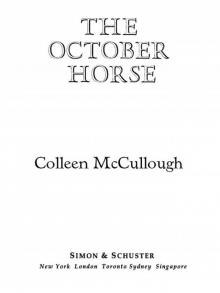 The October Horse: A Novel of Caesar and Cleopatra
The October Horse: A Novel of Caesar and Cleopatra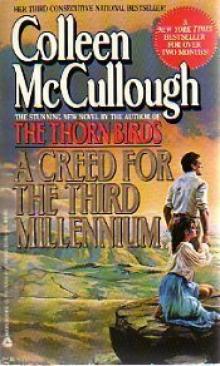 A Creed for the Third Millennium
A Creed for the Third Millennium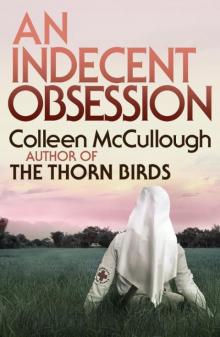 An Indecent Obsession
An Indecent Obsession The Thorn Birds
The Thorn Birds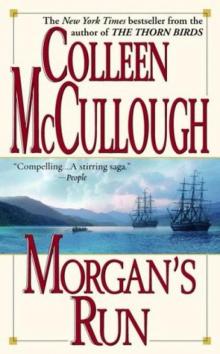 Morgan's Run
Morgan's Run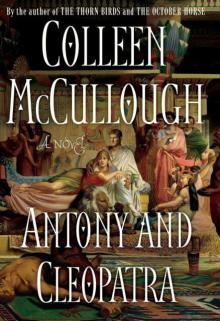 Antony and Cleopatra
Antony and Cleopatra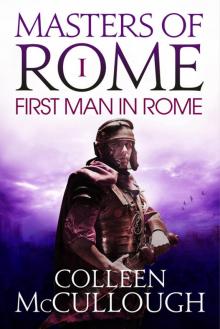 The First Man in Rome
The First Man in Rome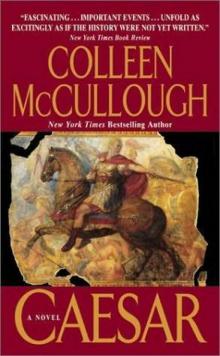 Caesar
Caesar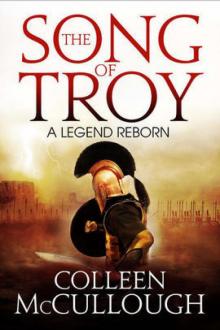 The Song of Troy
The Song of Troy Fortune's Favorites
Fortune's Favorites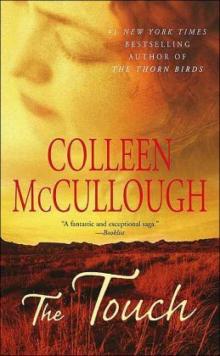 The Touch
The Touch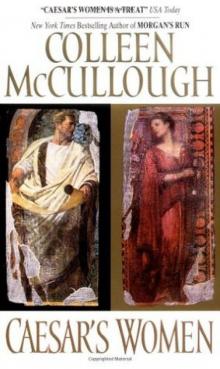 Caesar's Women
Caesar's Women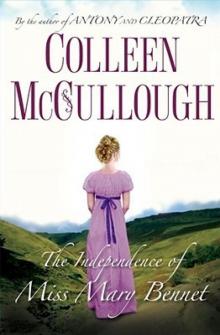 The Independence of Miss Mary Bennet
The Independence of Miss Mary Bennet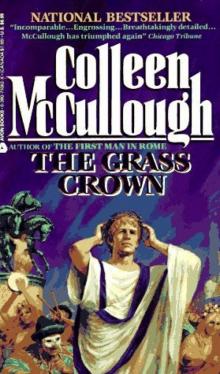 The Grass Crown
The Grass Crown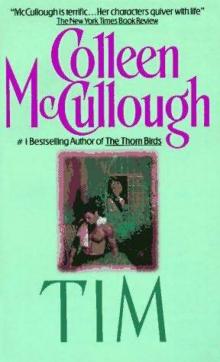 Tim
Tim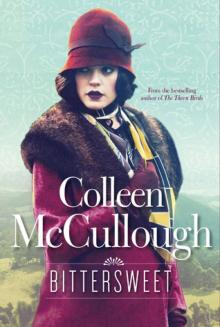 Bittersweet
Bittersweet Angel
Angel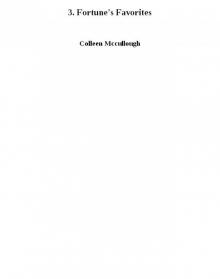 3. Fortune's Favorites
3. Fortune's Favorites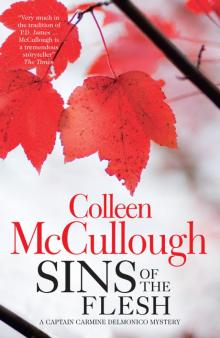 Sins of the Flesh
Sins of the Flesh 2. The Grass Crown
2. The Grass Crown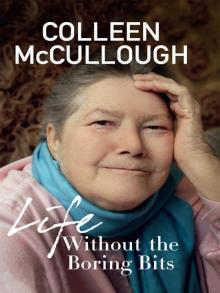 Life Without The Boring Bits
Life Without The Boring Bits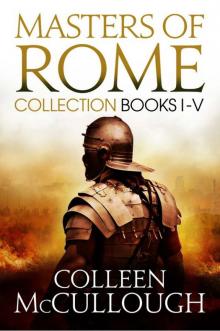 Masters of Rome Boxset: First Man in Rome, the Grass Crown, Fortune's Favourites, Caesar's Women, Caesar
Masters of Rome Boxset: First Man in Rome, the Grass Crown, Fortune's Favourites, Caesar's Women, Caesar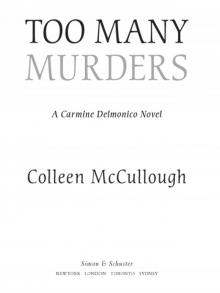 Too Many Murders
Too Many Murders 1. First Man in Rome
1. First Man in Rome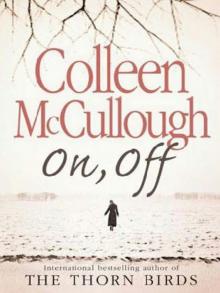 On, Off
On, Off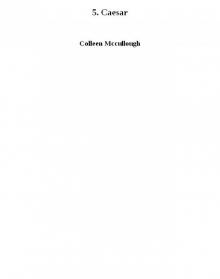 5. Caesar
5. Caesar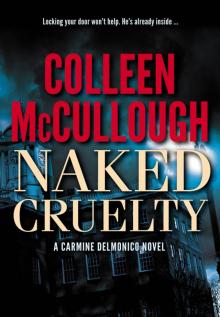 Naked Cruelty
Naked Cruelty 6. The October Horse: A Novel of Caesar and Cleopatra
6. The October Horse: A Novel of Caesar and Cleopatra